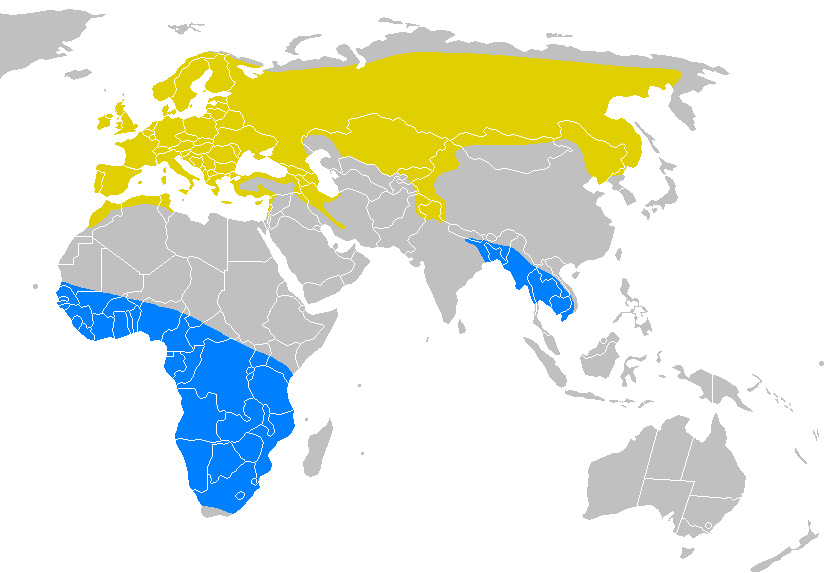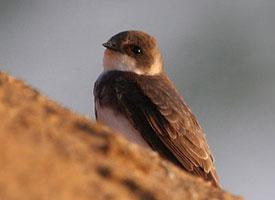
Váhy a míry
| Délka | 13 cm |
|---|---|
| Hmotnost | 18,3 g |
| Délka rozpětí křídel | od 26 do 29 cm |
Popis zvířete
The Western House Martin (Delichon urbicum), also commonly known simply as the House Martin, is a fascinating and highly adaptable bird species belonging to the swallow family. This small yet agile bird is renowned for its distinctive appearance and remarkable migratory patterns, captivating bird watchers and ornithologists alike.Physically, the Western House Martin is a compact bird, typically measuring about 13 centimeters in length and weighing around 20 grams. Its plumage is predominantly a glossy blue-black on the upper parts, providing a striking contrast to its pure white underparts. One of the most distinguishing features of this bird is its short, forked tail, which is complemented by a broad, white rump band that is clearly visible in flight. The bird's wings are pointed and long, designed for efficient and agile flight. The House Martin has a small, black bill and relatively short legs with small feet, adapted more for clinging to vertical surfaces rather than walking on the ground.
The habitat of the Western House Martin is quite varied, though it shows a preference for open and semi-open landscapes. It is commonly found in rural and suburban areas, where it often nests on buildings, under eaves, or in other man-made structures. This adaptability to human-altered environments has allowed the species to thrive in many areas. Originally native to Europe and parts of Asia and Africa, the bird has a widespread range due to its migratory nature.
One of the most remarkable aspects of the Western House Martin is its migratory behavior. Birds breeding in the cooler climates of Europe and northern Asia undertake long migrations to winter in Africa's warmer regions, covering thousands of kilometers in their seasonal movements. This migratory pattern highlights the bird's incredible endurance and navigational abilities.
Breeding season for the House Martin is a busy time, with pairs often returning to the same nesting sites year after year. Nests are meticulously constructed with mud pellets, which the birds collect in their beaks and fashion into bowl-shaped structures attached to vertical surfaces. Inside these nests, the female lays between two to five eggs, which both parents then incubate. Upon hatching, the chicks are fed a diet of insects caught in flight, showcasing the parents' adept flying and foraging skills.
The diet of the Western House Martin consists almost entirely of flying insects, including flies, aphids, and mosquitoes, making it a beneficial species for controlling insect populations. Its aerial feeding habits are a spectacle in themselves, with the bird skillfully maneuvering through the air to catch its prey.
Despite facing threats from habitat loss, pollution, and climate change, the Western House Martin remains a species of least concern according to the International Union for Conservation of Nature (IUCN), thanks to its wide range and large population. However, continued monitoring and conservation efforts are essential to ensure this charming bird remains a common sight in our skies and cities.
In summary, the Western House Martin is a small, agile bird with a distinctive appearance and fascinating behaviors. Its adaptability, migratory prowess, and role in insect control make it an important and cherished part of the ecosystem. Whether swooping through the air in search of insects or meticulously constructing its mud nest, the House Martin continues to enchant and inspire those who take the time to observe it.
Mapa výskytu

Podobná zvířata
Nové fotografie zvířat
Top 10 zvířat
- Dolphin gull (Leucophaeus scoresbii)
- Diana monkey (Cercopithecus diana)
- Moustached guenon (Cercopithecus cephus)
- Galápagos tortoise (Geochelone nigra complex)
- Japanese macaque (Macaca fuscata)
- Stone loach (Barbatula barbatula)
- Russian tortoise (Testudo horsfieldii)
- Greek tortoise (Testudo graeca)
- Common flying dragon (Draco volans)
- Vendace (Coregonus albula)


